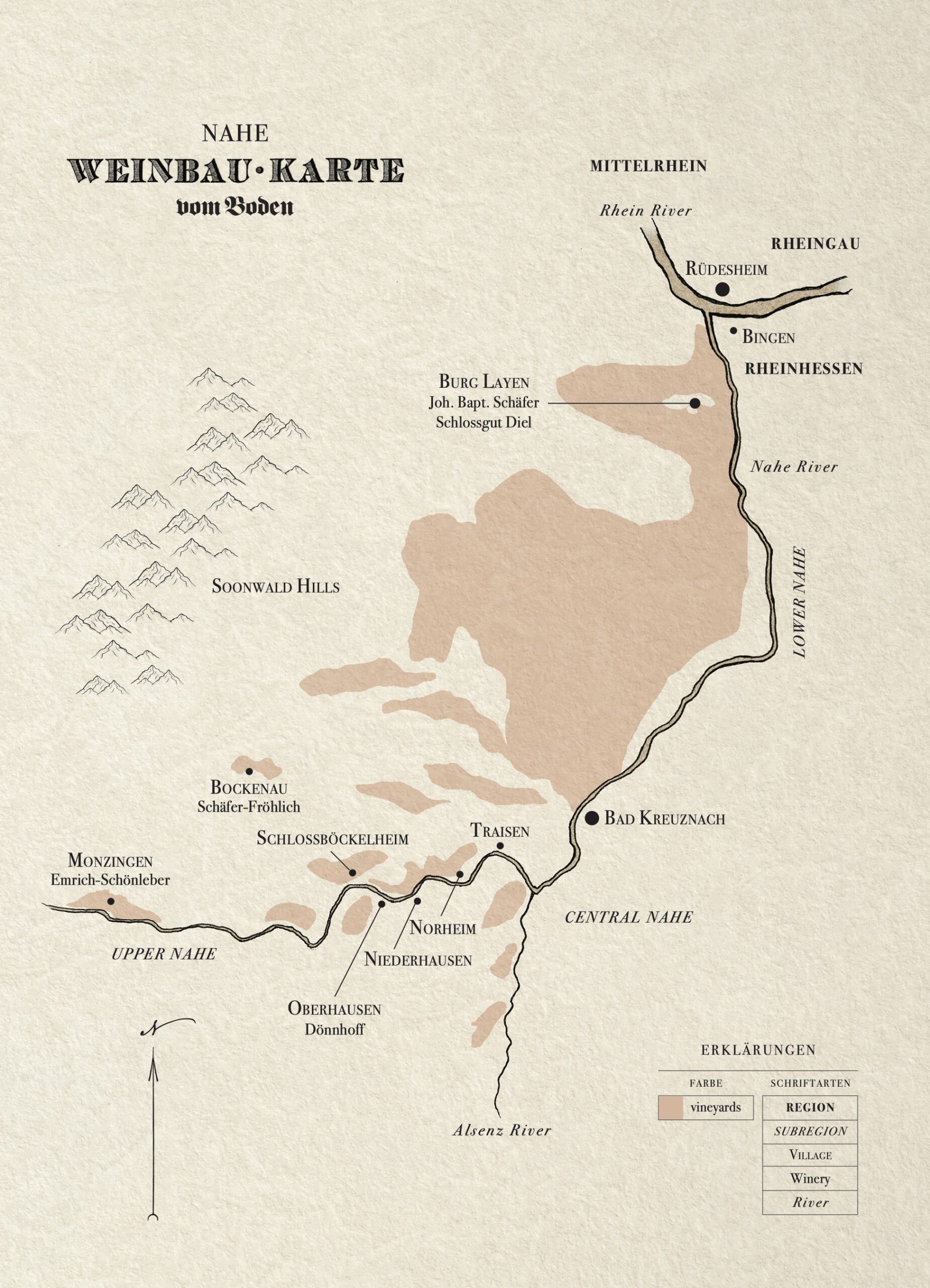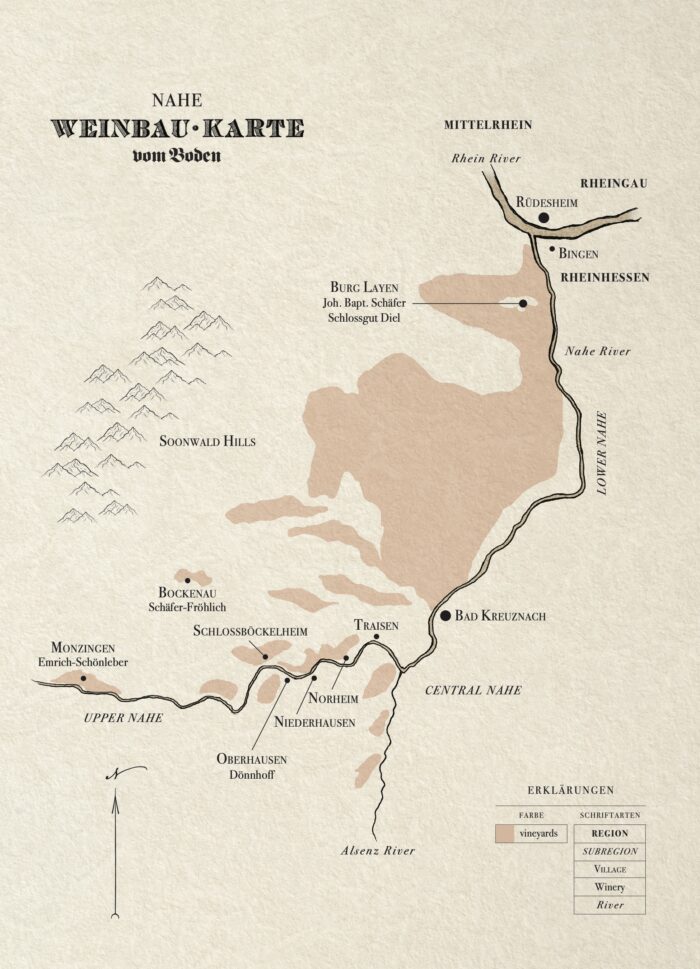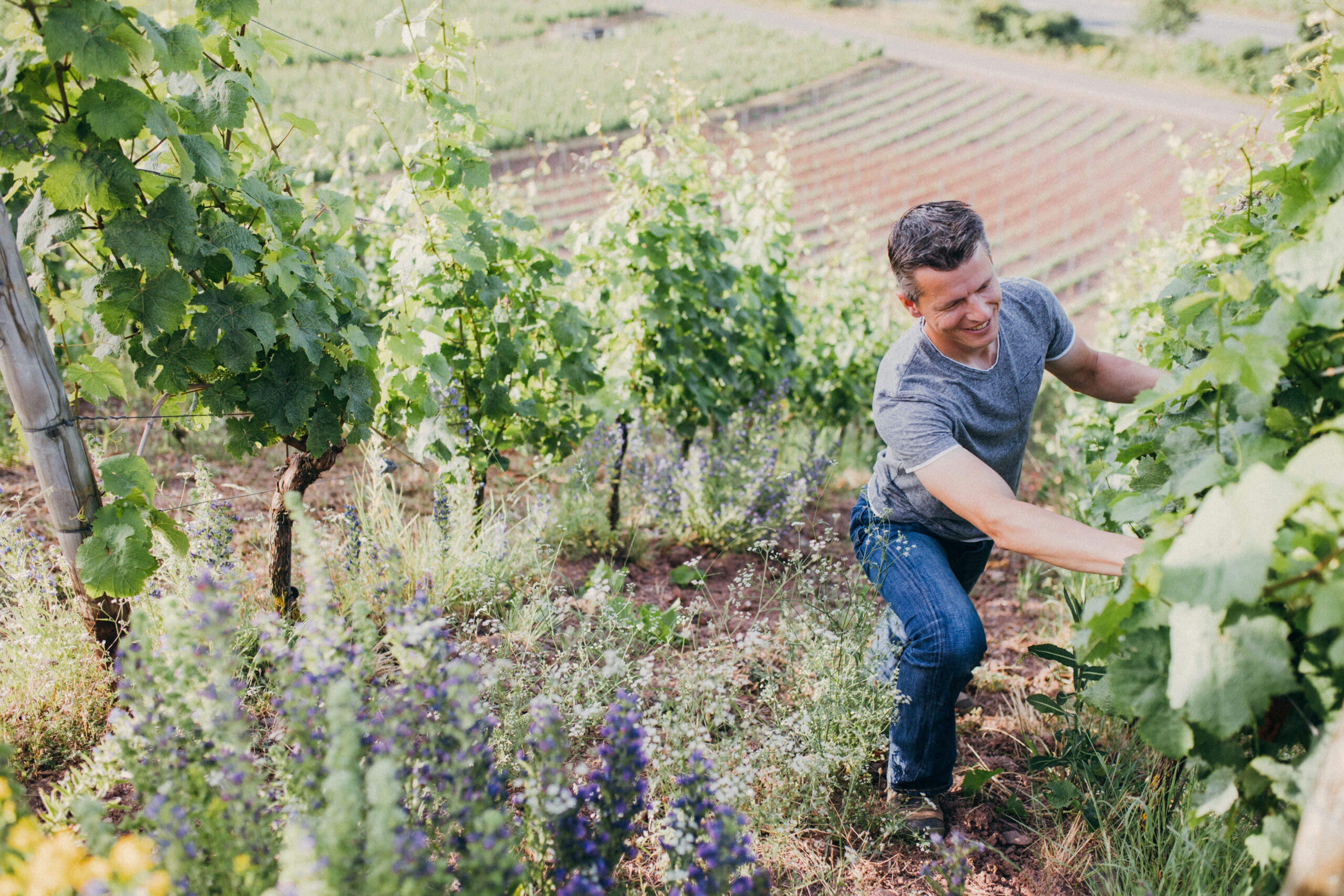
The Nahe is defined, as is nearly every wine region in Germany, by a river.
The river begins in the Hünsruck, a high plateau that frames the eastern side of the Moselle. The viticultural section of the Nahe River, beginning near Monzingen, is about 20 miles long, flowing east and then northeast and then north. It is a long, gentle bend north, tracing a hypothetical clock face from six o’clock up to three o’clock. At its northernmost point, the Nahe empties into the Rhein. This very point, where the Nahe meets the Rhein, is the meeting point of no less then four wine regions: the Nahe, Rheinhessen, Rheingau, and Mittelrhein. The western side of the Nahe is the Nahe wine region; the eastern side is the beginning of the Rheinhessen. Directly north, right across the broad expanse of the Rhein River, the most famous sites of the Rheingau’s Rüdesheim village stand proud and tall: Berg Schlossberg, Berg Roseneck, and Berg Rottland. Turn slightly to the west to watch the Rhein flow more northwest, and you are staring into the Mittelrhein. Hopefully this provides a general orientation.
Let’s begin our journey through the Nahe upstream, closer to its source. The upper Nahe is perhaps the coldest part of the region. The wines of this part of the Nahe are said to be the most Saar-like, as we’ve discussed. For our purposes, the only village of the upper Nahe is Monzingen, which is the home village of Emrich-Schönleber.
This village represents something of an island of vines; there is little in the way of important viticulture until one reaches the central Nahe around Schlossböckelheim, roughly five miles downstream. Although this village is alone, separated from most of the Nahe, Monzingen is a very important place. Its two most famous sites are among the greatest sites in the Nahe: the Halenberg and Frühlingsplätzchen. And indeed their steeliness, their Saar-like-ness, is reflected in the landscape as well. Both the Saar and this part of the Nahe are open valleys. The vineyards in this part of the Nahe are exposed to cool air that comes down the valley from the Hünsruck; the wines show a certain nerviness because of this. These sites are farmed by both Emrich-Schönleber and Schäfer-Fröhlich, making for one of the most thrilling terroir-and-winemaker side-by- sides — highly recommended.
From Monzingen it’s about a 15-minute drive to Schlossböckelheim; for me, this is where the central Nahe begins.
This is also where one begins to flip through the Rolodex of the sites well known in the U.S., made famous by Dönnhoff and later Schäfer-Fröhlich: Felsenberg, Kupfergrube, Brücke, Hermannshöhle, Dellchen, Kirschheck, and Bastei, a tiny 1.4-hectare site sandwiched between the Nahe River and the Rotenfels, a 1,072-foot-tall sheer rock face, the largest, you will be told, north of the Alps. This is a beautiful place, dramatic, with fantastically complex exposures, soils, and micro- climates. It is a bit more of a closed valley here, perhaps closer to the Moselle than to the Saar. And indeed, if one were to flex and reach for true wine dorkdom, one could suggest that if the upper Nahe is more Saar-like, perhaps the central Nahe flirts a bit more with a Moselle tone? Regardless, this is a holy place. One of Helmut Dönnhoff’s many profound realizations was the range of expression, not only possible but absolutely inherent, in sites that are direct neighbors, from the seductive, often-botrytis-enhanced curves of Brücke to the finessed completeness of Hermannshöhle to the earthy complexity of Kupfergrube. These are not subtle differences; they are profound actualizations of terroir. In short, this little stretch of the river deserves its considerable fame. And no, nothing is simple in the Nahe.
Finally, beginning after the larger city of Bad Kreuznach we come to the lower Nahe.
The lower Nahe is a place that has eluded the fame of the upper and central Nahe, at least in the U.S. The top sites here creep into side valleys on the western side of the Nahe, in many cases lining the northern flanks of small tributaries that flow in an easterly direction into the Nahe.
For the American wine fan, the most important sites of this lower Nahe are situated on the northern side of the Trollbach stream, which runs east into the Nahe. Here you’ll find a trio of contiguous sites: Pittermännchen, Goldloch, and Burgberg. These sites are farmed most famously by Caroline Diel, though the wines of Sebastian Schäfer of Joh. Bapt. Schäfer deserve some further exposure and recognition in the U.S. Schäfer farms parcels in the Pittermännchen and Goldloch. As stated, the wines of the lower Nahe are said to be more “Rhein-like” in their quality — broader, earthier. Perhaps this is true. Either way, the differences between the upper and the lower Nahe can be dramatic. Anne Krebiehl writes that there can be a vegetative difference of up to two weeks between the warmer lower Nahe and the cooler upper Nahe. Saar to Moselle to Rhein, upper Nahe to central to lower Nahe, separated by two weeks? Nothing is that straightforward or easy, but the comparisons hint at the complexity of the Nahe.
You may have noticed, that this quick summary leaves out one very important person and one very important place.
And the two are almost synonymous: Tim Fröhlich of Schäfer-Fröhlich and his beloved Felseneck. While Tim farms no less than four famous vineyards in the upper and central Nahe — the Halenberg, Frühlingsplätzchen, Felsenberg, and Kupfergrube — two of his Grand Cru sites, the Felseneck and the Stromberg, rest some three miles northwest of Schlossböckelheim, away from the river and up into the forested hills of the Soonwald. Neither the village nor the sites are mentioned in any real detail in the first important wine map of the region originally published in 1901. In the 2007 Wine Atlas of Germany, the Felseneck is listed not as an “Exceptional Vineyard,” but at a rung lower, as a “Superior Vineyard.”
For me, these curious historical notations mean little in terms of the quality and potential of these places. They are rather just another reminder of how quickly this region has come into the spotlight.
